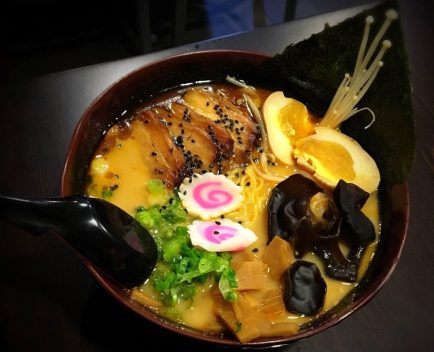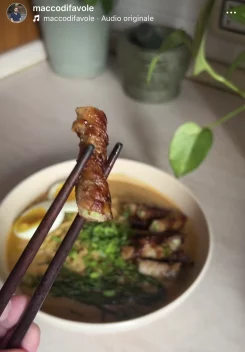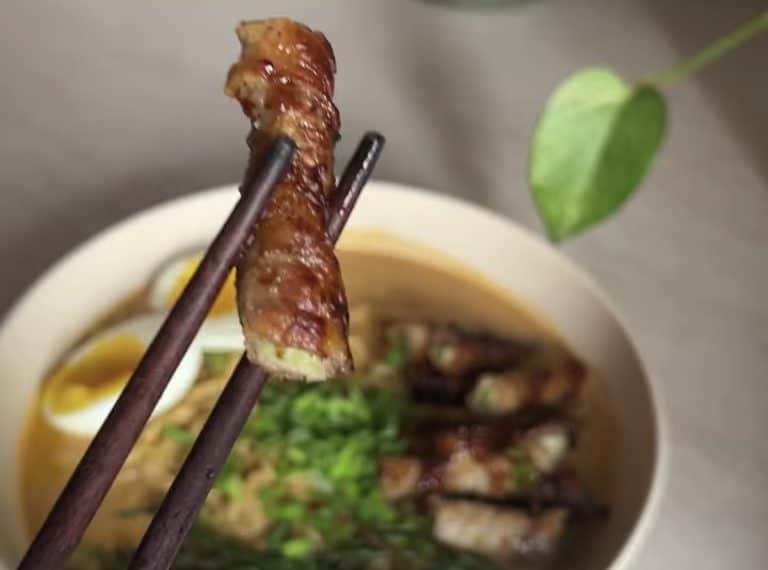The trajectory of Japanese cuisine in Italy has passed from the absolute dominance of the sushi-sashimi and tempura triad to the subsequent discovery of other dishes that many had only seen in cartoons, without direct experience until the first ramen bars appeared here too. It was a small peaceful invasion that made us discover simple places to eat everyday dishes that in Japan (as in Italy, for that matter) consist of pasta, ravioli, meats, and fish cooked on a grill or griddle, but above all ramen: the typical hearty soup prepared with an intense broth of meat or fish, enriched with soy or miso, complemented by seaweed, vegetables, pork belly, sprouts, noodles, and the ever-present marinated egg. A soup with many variations, effectively a customizable recipe.

So we began to know and appreciate this hearty dish, perfect for cold rainy evenings. The further step was to make it our own, Italianize it, blending Japanese and Italian culture, adding very Italian ingredients or preparations. We have seen the same happen with other dishes of foreign origin. The example of gyoza, empanadas, or tacos is emblematic: filled with hunter-style chicken or oxtail, they are a tasty and not at all out-of-focus intersection. So over time, some have started to do the same with ramen, reinterpreting the traditional soup in light of Italian flavors. The carbonara ramen has raised some perplexity and as many praises, the same with proposals enriched with seasonal vegetables, perhaps regional ones like "tenerumi". And it is precisely from Trinacria that a Sicilian version of ramen comes that has convinced us very much, and it is the one seen on the Instagram profile Maccodifavole where practically every element of the soup is replaced by other Sicilian ones. According to us, it's worth trying.

Sicilian Ramen
We start with the liquid part, inspired by a Japanese variant of ramen with soy milk and sesame paste, tantanmen. The fundamental element is the flavoring that is prepared by "popping" two cloves of garlic in seed oil in a pan; after removing the cloves, add 3 or 4 anchovies, a tablespoon of tomato paste, and a spoonful of anchovy sauce that gives the umami note, always on the heat add 4 or 5 tablespoons of almond butter prepared by blending toasted almonds (which replaces the sesame paste). For the broth, you need 200 ml of water and 400 ml of unsweetened soy milk in which to cook for 20 minutes a bunch of Sicilian wild fennel.

Instead of pork belly, there are "mangia e bevi" from Palermo, rolls of thinly sliced bacon wrapped around a spring onion, glazed with an emulsion of oil, lemon, and Sicilian citrus honey, and then baked in the oven; while wild asparagus are simply sautéed in a pan. The egg is soft-boiled, cooked for 5 minutes and then passed in ice water to stop the cooking. At this point, the author assembles the ramen: pour the broth into the flavoring, emulsify with a whisk and then proceed to assemble everything in the bowl with the noodles (those are the classic Japanese ones), place the various elements and the spring onion on top. It seems really interesting to us: now all that's left is to try it, and wait for the "pescetarian" version already announced.


 Meloni: "Tariffs? If necessary, there will be consequences. Heavy impact on agri-food sector"
Meloni: "Tariffs? If necessary, there will be consequences. Heavy impact on agri-food sector" The Government honours the greats of Italian cuisine, from Bottura to Pepe. Massari: "Thank you, Meloni, the only one who listened to us"
The Government honours the greats of Italian cuisine, from Bottura to Pepe. Massari: "Thank you, Meloni, the only one who listened to us" "We must promote a cuisine that is not just for the few." Interview with Massimo Bottura
"We must promote a cuisine that is not just for the few." Interview with Massimo Bottura Wine was a drink of the people as early as the Early Bronze Age. A study disproves the ancient elitism of Bacchus’ nectar
Wine was a drink of the people as early as the Early Bronze Age. A study disproves the ancient elitism of Bacchus’ nectar "From 2nd April, US tariffs between 10% and 25% on wine as well." The announcement from the Wine Trade Alliance
"From 2nd April, US tariffs between 10% and 25% on wine as well." The announcement from the Wine Trade Alliance






